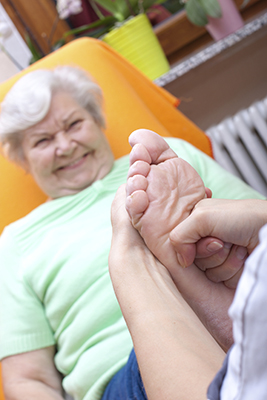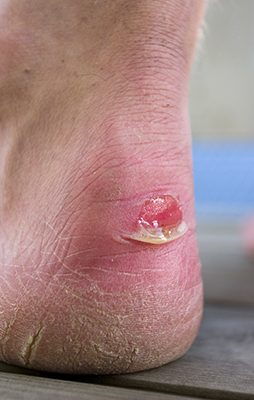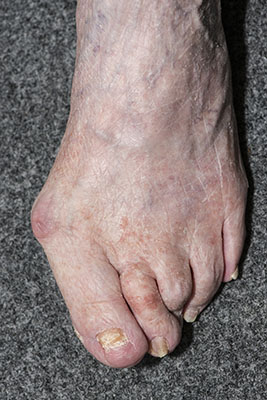 Diabetic foot is one of the top 20 causes of hospitalization in Australia. Studies conducted in the country found that one in every twenty-two patients in Australian hospitals have active diabetic foot disease. The disease is also responsible for over 4,400 amputations and 1,700 deaths each year. Nevertheless, early prevention is the best way to assure that diabetic foot does not progress into something much worse. It is recommended that every diabetic who goes to a hospital asks to have their foot screened for diabetic foot. Many people who have the disease often aren’t aware of it.
Diabetic foot is one of the top 20 causes of hospitalization in Australia. Studies conducted in the country found that one in every twenty-two patients in Australian hospitals have active diabetic foot disease. The disease is also responsible for over 4,400 amputations and 1,700 deaths each year. Nevertheless, early prevention is the best way to assure that diabetic foot does not progress into something much worse. It is recommended that every diabetic who goes to a hospital asks to have their foot screened for diabetic foot. Many people who have the disease often aren’t aware of it.
Diabetic foot care is important in preventing foot ailments such as ulcers. If you are suffering from diabetes or have any other concerns about your feet contact one of our podiatrists from Southeast Podiatry. Our doctors can provide the care you need to keep your pain free and on your feet.
Diabetic Foot Care
Diabetes affects millions of people every year. Diabetes can damage blood vessels in many parts of the body, including the feet. Because of this, taking care of your feet is essential if you have diabetes, and having a podiatrist help monitor your foot health is highly recommended.
The Importance of Caring for Your Feet
Patients with diabetes should have their doctor monitor their blood levels because blood sugar levels play such a huge role in diabetic care. Monitoring these levels on a regular basis is highly advised.
It is always best to inform your healthcare professional of any concerns you may have regarding your feet, especially for diabetic patients. Early treatment and routine foot examinations are keys to maintaining proper health, especially because severe complications can arise if proper treatment is not applied.
If you have any questions please feel free to contact one of our offices located in Fairhope, Brewton, and Atmore, AL. We offer the newest diagnostic and treatment technologies for all your foot care needs.
Read more about Diabetic Foot Care
 Blisters are a fairly common foot condition that can be easily prevented with a few simple steps. The first step is to always ensure the feet or kept clean to prevent any germs or bacteria from penetrating the skin. Wearing the right pair of socks can also help support the feet and reduce friction, which can create blisters. Applying bandages or band aids to any already existing blisters can help reduce excess heat or additional friction that can exacerbate the blister.
Blisters are a fairly common foot condition that can be easily prevented with a few simple steps. The first step is to always ensure the feet or kept clean to prevent any germs or bacteria from penetrating the skin. Wearing the right pair of socks can also help support the feet and reduce friction, which can create blisters. Applying bandages or band aids to any already existing blisters can help reduce excess heat or additional friction that can exacerbate the blister.
Blisters are prone to making everyday activities extremely uncomfortable. If your feet are hurting, contact one of our podiatrists from Southeast Podiatry. Our doctors will assist you with all of your podiatric concerns.
Foot Blisters
Foot blisters develop as a result of constantly wearing tight or ill-fitting footwear. This happens due to the constant rubbing from the shoe, which can often lead to pain.
What are Foot Blisters?
A foot blister is a small fluid-filled pocket that forms on the upper-most layer of the skin. Blisters are filled with clear fluid and can lead to blood drainage or pus if the area becomes infected.
How do Blisters Form?
Blisters on the feet are often the result of constant friction of skin and material, usually by shoe rubbing. Walking in sandals, boots, or shoes that don’t fit properly for long periods of time can result in a blister. Having consistent foot moisture and humidity can easily lead to blister formation.
Prevention & Treatment
It is important to properly care for the affected area in order to prevent infection and ease the pain. Do not lance the blister and use a Band-Aid to provide pain relief. Also, be sure to keep your feet dry and wear proper fitting shoes. If you see blood or pus in a blister, seek assistance from a podiatrist.
If you have any questions please contact our offices located in Fairhope, Brewton, and Atmore, AL. We offer the newest diagnostic and treatment technologies for all your foot care needs.
Read more about blisters on the feet
Blisters are a common ailment of people who wear shoes that are either too tight or rub against the feet in an uncomfortable way. Knowing the basics of blisters is important for understanding how they are formed and what treatments should be used for them.
A blister on the foot, or any other part of the body, is a small pocket that is filled with fluid. It usually forms on the upper layer of the skin because these layers are loose enough to allow a blister to form. The most common fluid in a blister is just a clear, watery-like fluid that usually isn’t cause for concern. However, blisters can fill up with blood if they are deep enough and pus if they have become infected with bacteria.
Blisters almost always form on the feet due to shoes rubbing up against the foot, where the friction causes blisters. These can occur after you have walked for a long period of time or when your shoes do not fit you properly. Your feet are also more prone to blisters if they are moist, so keeping them dry and clean is one preventative step you can take.
Preventing infection should be the number one concern when treating blisters, as well as relieving the pain they can cause. Using a bandage to cover up the blister will help it heal and prevent bacteria from entering it. New skin will form under the blister and eventually cause it to pop. You can also take a sterilized pin and try to pop it yourself.
If the blister is filled with pus or blood, seeking treatment from a doctor is ideal. Antibiotics may need to be taken in order to completely eliminate the bacteria inside the blister. See a doctor to have an antibiotic prescribed.
The best way to treat blisters is to prevent them all together. Keeping your feet dry and making sure that your shoes fit properly are just two of the steps you can take to prevent blisters. Shoes that are too tight or shoes that are too loose and allow your feet to slide in them will cause blisters. Applying a bandage to an area where you think a blister is about to form is another way you can prevent them.
 Hallux valgus, which is more commonly known as a bunion, is a deformity of the joint at the base of the big toe. Most people who have bunions develop them from wearing uncomfortable shoes for a long period of time. Women are more likely to have bunions compared to men because they often wear high heels. Bunions are not a life threatening condition; however they can negatively impact one’s quality of life. There are a few non-surgical options for those wishing to treat their bunions. Physiotherapy and the use of devices such as bunion splints and toe spacers can work to alleviate bunion pain; however they may not be effective in the long run.
Hallux valgus, which is more commonly known as a bunion, is a deformity of the joint at the base of the big toe. Most people who have bunions develop them from wearing uncomfortable shoes for a long period of time. Women are more likely to have bunions compared to men because they often wear high heels. Bunions are not a life threatening condition; however they can negatively impact one’s quality of life. There are a few non-surgical options for those wishing to treat their bunions. Physiotherapy and the use of devices such as bunion splints and toe spacers can work to alleviate bunion pain; however they may not be effective in the long run.
Bunion surgery usually occurs after non-surgical methods have proved to be ineffective. If you have any concerns, contact one of our podiatrists from Southeast Podiatry. Our doctors will assess your injury and provide you with quality treatment.
What is a Bunion?
A bunion is formed of swollen tissue or an enlargement of boney growth, usually located at the base joint of the toe that connects to the foot. The swelling occurs by the bones in the big toe shifting inward, which impacts the other toes of the foot. This causes the area around the base of the big toe to become inflamed and painful.
Why do Bunions Form?
How are Bunions Diagnosed?
Doctors often perform two tests – blood tests and x-rays – when trying to diagnose bunions, especially in the early stages of development. Blood tests help determine if the foot pain is being caused by something else, such as arthritis, while x-rays provide a clear picture of your bone structure to your doctor.
How are Bunions Treated?
If you have any questions please contact our offices located in Fairhope, Brewton, and Atmore, AL.We offer the newest diagnostic and treatment technologies for all your foot care needs.
Read more about bunions.
A bunion is an enlargement of the base joint of the toe that connects to the foot, often formed from a bony growth or a patch of swollen tissues. It is caused by the shifting of the big toe bone inward towards the other toes. This shift can cause a serious amount of pain and discomfort. The area around the big toe can become inflamed, red, and painful.
Bunions are most commonly formed in people who are already genetically predisposed to them or other kinds of bone displacements. However, even if you do not have a history of this in your family, you can still develop bunions if you are wearing improperly fitting shoes. This can happen as you try to cram your feet into high heels, or by running or walking in a way that causes too much stress on the feet. High heels are another major culprit in the formation of bunions. Not only do they push the big toe inward, but your body weight and center of gravity is shifted towards the edge of your feet and your toes, which can cause bone displacement.
Bunions are quickly and easily diagnosed by podiatrists. However, because of their nature, they can appear similar to arthritic conditions or gout. A blood test is sometimes required to fully diagnose a bunion. A full radiological or x-ray exam could also be done by a podiatrist to examine the bone structure of your feet. One thing that is looked for specifically is an enlargement of that base joint or evidence of the big toe bone being pushed inward.
One of the first things to do if you have bunions is to get a larger, wider shoe that can remove pressure from your toes. This usually means that high heels should be eliminated from use for a period of time to allow the bunion to heel. Eliminating the pressure placed on a bunion is often enough to eliminate the pain involved with them. However, pain can persist in some instances and anti-inflammatory drugs may be prescribed. If the pain is too severe, steroid injections near the bunion or even surgery may be required. Orthotics for shoes may also be prescribed which can alleviate the pain of bunions by removing pressure from them. However, these methods simply stop the pain of bunions but do not correct the problem at its source.
As previously mentioned, surgery may be an option to completely eliminate your bunions. Surgery is done to reposition the toe bones so that they no longer face inward. This can be done by removing a section of bone or by rearranging the ligaments and tendons in the toe to help them align properly. Even after the surgery, it may be necessary to wear protective shoes for a while to ensure that the bunions do not return.